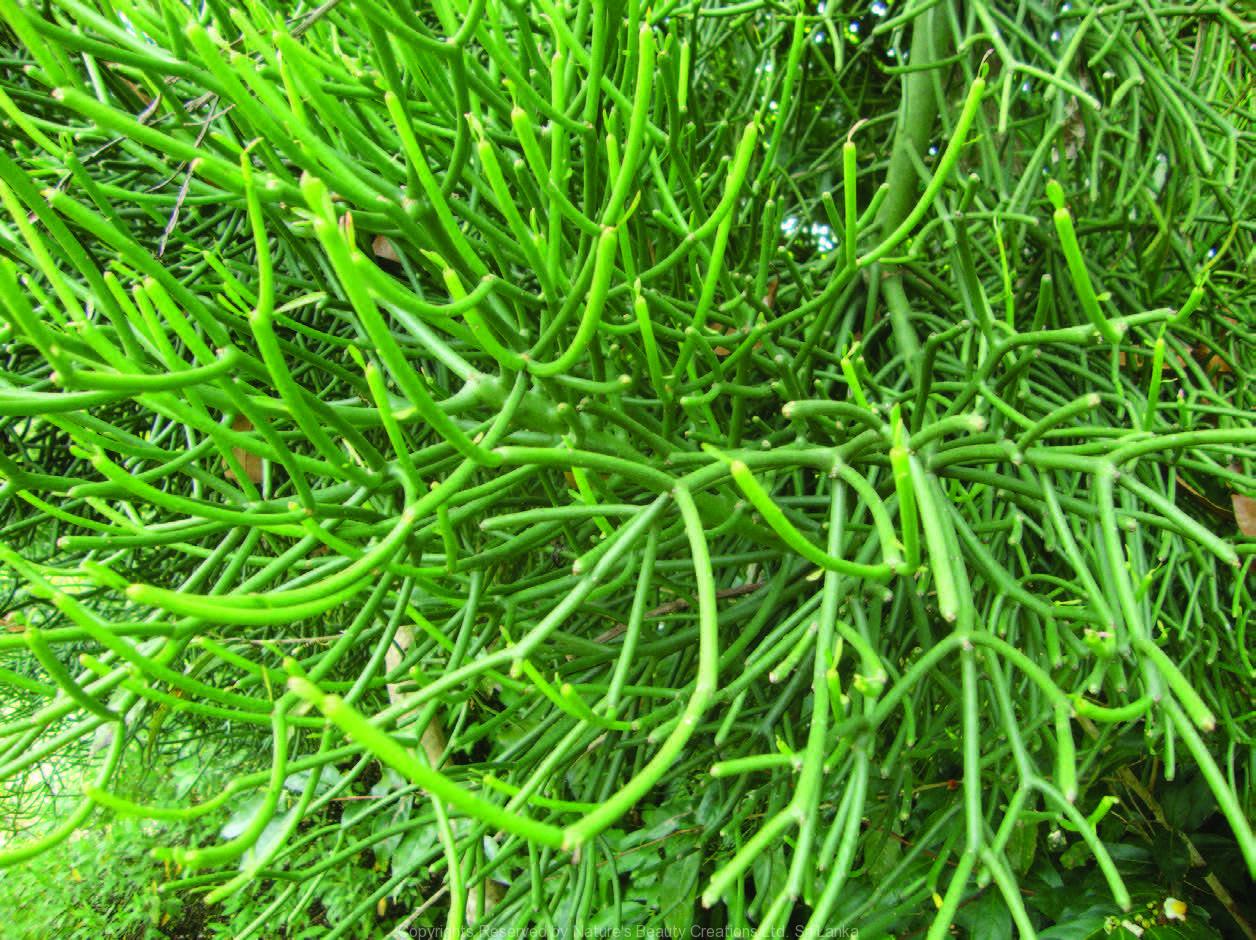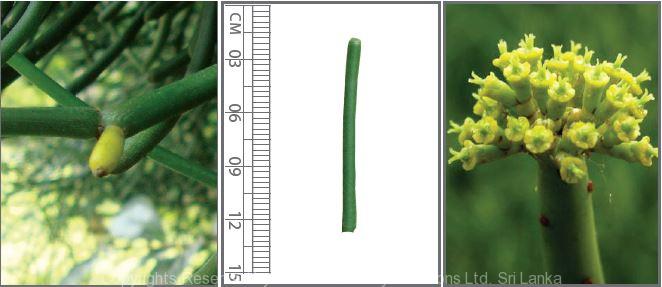

Traditional Knowledge
Useful plant parts :
Milky juice of young stem
Uses in traditional medicine :
- Milky juice ofthe young stems, collected to a cotton cloth, is applied on painful joints to treat rheumatism
Scientific Research
Chemical constituents:
Sitosterol, stigmasterol, campesterol, palmitic and linoleic acids from callus; proteolytic enzymes: euphorbains t1–t4 from latex; triterpenes: euphorginol, euphorcinol from fresh stem bark and euphol, 4-deoxyphorbol esters and diesters from plant
Bioactivity :
Aqueous and methanol extract of stem: antibacterial; latex: anti-inflammatory; aqueous extract of aerial parts: antioxidative, hepatoprotective; 4-deoxyphorbol esters: enhances Epstein- bar virus infection of B lymphocytes, skin irritant, tumor promotor; latex and stem bark extracts: Culex quinquefasciatus larvicidal; biopolymeric fraction of plant: antiarthritic; euphol: cytotoxic againt human gastric cancer cells
Clinical:
References : Bani, S. et al., (2007), Anti-arthritic activity of a biopolymeric fraction from Euphorbia tirucalli, J Ethnopharmacol, 110(1), 92-8. Furstenberger, G. and Hecker, E., (1985), On the active principles of the spurge family (Euphorbiaceae). XI. The skin irritant and tumor promoting diterpene esters of Euphorbia tirucalli L. originating from South Africa, Z Naturforsch C, 40(9-10), 631-46. Furstenberger, G. and Hecker, E., (1986), On the active principles of the Euphorbiaceae, XII. Highly unsaturated irritant diterpene esters from Euphorbia tirucalli originating from Madagascar, J Nat Prod, 49(3), 386-97. Imai, S. et al., (1994), African Burkitt’s lymphoma: a plant, Euphorbia tirucalli, reduces Epstein-Barr virus-specific cellular immunity, Anticancer Res, 14(3A), 933-6. Khan, A. Q. et al., (1987), Further Triterpenes from the Stem Bark of Euphorbia tirucalli, Planta Med, 53(6), 577. Khan, A. Q. et al., (1989), Euphorcinol: A New Pentacyclic Triterpene from Euphorbia tirucalli, Planta Med, 55(3), 290-1. Kinghorn, A. D., (1979), Characterization of an irritant 4-deoxyphorbol diester from Euphorbia tirucalli, J Nat Prod, 42(1), 112-5. Lin, M. W. et al., (2012), Euphol from Euphorbia tirucalli selectively inhibits human gastric cancer cell growth through the induction of ERK1/2-mediated apoptosis, Food Chem Toxicol, 50(12), 4333-9. Yadav, R. et al., (2002), Larvicidal activity of latex and stem bark of Euphorbia tirucalli plant on the mosquito Culex quinquefasciatus, J Commun Dis, 34(4), 264-9. Jyothi, T. M. et al., (2008), Hepatoprotective and Antioxidant Activity of Euphorbia tirucalli, Iranian journal of pharmacology & therapeutics, 7, 25-30. Khan, A. Q. et al., (1988), Cycloeuphordenol, a new triterpene from Euphorbia tirucalli, Phytochemistry, 27(7), 2279-2281. Lynn, K. R. and Radford, N. A. C., (1985), Four serine proteases from the latex of Euphorbia tirucalli, Canadian Journal of Biochemistry and Cell Biology, 63(10), 1093-1096. Parekh, J. et al., (2005), Efficacy of Aqueous and Methanol Extracts of Some Medicinal Plants for Potential Antibacterial Activity, Turkish Journal of Biology, 29, 203-210. Prabha, M. N. et al., (2008), Studies on anti-inflammatory and analgesic activities of Euphorbia tirucalli L. latex, International Journal of Chemical Sciences, 6(4), 1781-1787 Rasool, N. et al., (1989), A taraxerane type triterpene from Euphorbia tirucalli, Phytochemistry, 28(4), 1193-1195. Yamamoto, Y. et al., (1981), Chemical constituents of cultured cells of Euphorbia tirucalli and E. millii, Plant cell reports, 1(1), 29-30.
Copyrights Reserved By
Natures Beauty Creations



